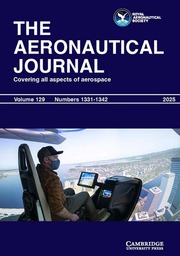Hydrogen-air lean premixed turbulent highly swirled flames stabilisation
The Aeronautical Journal June 2025 Vol 129 No 1336

Reducing nitrogen oxides emissions from aviation has been an endeavor for the aeronautics industry for several decades along with increasing efficiencies of turbofan engines. The level of nitrogen oxides emission has dropped significantly since 2010 [1] and engine efficiency has been improved considerably since the beginning of commercial aviation [2]. Today, eliminating the carbon footprint from aviation to fill future narrow-body and wide-body aircraft engine needs, renews the role of combustion sciences and technologies. Clean combustion mode combined with carbon-free fuels provides a new avenue to overcome the challenges associated with future high-powered systems such as commercial aircraft. The article by Palies and Premchand focuses on demonstrating experimentally a clean combustion mode (called swirled lean fully premixed) with a clean fuel (hydrogen) at the laboratory scale. Operating in the lean regime enables reducing the nitrogen oxides emission considerably as the temperature is reduced compared to the stoichiometry yet meeting the thrust performance requirements [3].
The paper by Palies and Premchand tackles the combination of clean combustion mode and carbon-free fuel at the laboratory scale with both theoretical and experimental research. It results in key advances as the lean fully premixed highly swirled regime was not documented to date in the literature. This is especially important because swirled flames are typically used in aircraft engines because of their compact sizes.
The experimental setup located in the United States of America that is utilised for this study is an evolution of the one whose development started in 2007 in France [4]. The operating conditions for this experiment are given as function of the flame equivalence ratio and the mixture axial bulk velocity. The diagnostics for the measurements consist of shadowgraphs and flame’s emitted wavelength imaging (combination of chemiluminescence OH* and water-vapor infrared signals). The pioneering results report stabilised flames without combustion instabilities, flashback, blow-out or blow-off demonstrating the capacity to stabilise lean fully premixed hydrogen-air highly-swirled flames. These experimental results are compared to the theoretical predictions on a flame stabilisation map. The theory that is formed to obtain this map relies on the decomposition of the flowfield into static and dynamic components combined with the kinematic flame front condition [5]. It yields a criterion for flame stabilisation. The roles of the three velocity components of the swirling flow, along with the stretched flame displacement speed, and the quenching distance are discussed with respect to the flame stabilisation as well as how flashback is mitigated.
In addition, as this article shows that processes such as flashback, LBO and flameout can be avoided, conditions to operate fully premixed highly swirled flames exist. Additional companion works propose extending the present research to realistic operating conditions and thus make fully premixed swirled flame engines a possible reality in the upcoming years. A potential disruption for decarbonisation.
The paper Hydrogen-air lean premixed turbulent highly swirled flames stabilisation: experimental demonstration and mechanistic-kinematic description by P. Palies and C.P. Premchand appears in Volume 129 Issue 1336 of The Aeronautical Journal and is available open access.
[1] Yin F, Rao AG. Performance analysis of an aero engine with inter-stage turbine burner. The Aeronautical Journal. 2017;121(1245):1605-1626. doi:10.1017/aer.2017.93
[2] Epstein, A. H. (2014). Aeropropulsion for commercial aviation in the twenty-first century and research directions needed. AIAA journal, 52(5), 901-911.
[3] Palies, P. Premixed swirl-stabilized hydrogen-air flame-based turbofan: elements on combustion, combustor, and performance. Towards Sustainable Aviation Summit (TSAS) proceedings. 2025. doi:10.60711/TSAS25.20250321.7123429964022339
[4] Palies, P., Durox, D., Schuller, T., Morenton, P., & Candel, S. (2009). Dynamics of premixed confined swirling flames. Comptes Rendus Mecanique, 337(6-7), 395-405. [5] Palies, P. (2022). The flame displacement speed: a key quantity for turbulent combustion and combustion instability. International Journal of Spray and Combustion Dynamics, 14 (1-2), 4-16.

The Aeronautical Journal has, for over a century, been the UK’s leading scientific and technical aeronautics Journal and is the world’s oldest Aerospace Journal that remains in production. Published monthly, The Aeronautical Journal draws upon the expertise and resources of The Royal Aeronautical Society providing a world-wide forum for authors from the UK and overseas. Research papers are solicited on all aspects of research, design and development, construction and operation of aircraft and space vehicles. Papers are also welcomed which review, comprehensively, the results of recent research developments in any of the above topics.
The Royal Aeronautical Society is the world’s only professional body dedicated to the entire aerospace community. Established in 1866 to further the art, science and engineering of aeronautics, the Society has been at the forefront of developments ever since.
www.aerosociety.com | National Aerospace Library catalogue & e-books
Book reviews covering academic, scientific and technical books covering aeronautical engineering and topics relating to it can be found here: www.aerosociety.com/news-expertise/national-aerospace-library/book-reviews





